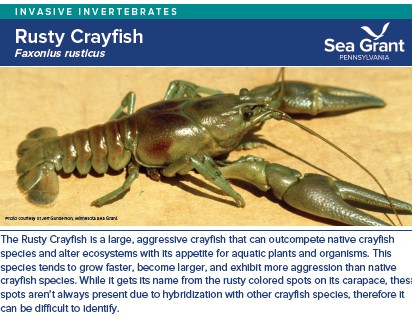
Rusty Crayfish (Faxonius rusticus)
Species at a Glance
The Rusty Crayfish is a large, aggressive crayfish that can outcompete native crayfish species and alter ecosystems with its appetite for aquatic plants and organisms. This species tends to grow faster, become larger, and exhibit more aggression than native crayfish species. While it gets its name from the rusty colored spots on its carapace, these spots aren’t always present due to hybridization with other crayfish species, therefore it can be difficult to identify.
Species Description
Adult Rusty Crayfish reach a maximum length of 10 cm (4 in) long with large, robust claws that display red or black banded tips. Coloration of the body is typically light brown to green or bluish with a dark red spot on either side of the carapace, which is its protective outer covering. The spots make it look as if the crayfish was picked up by someone with paint on their fingers. Due to the hybridization of male Rusty Crayfish with female native crayfish, these spots may not always be present or well-developed, therefore true identification may require assistance from a professional.
Native & Introduced Ranges
The Rusty Crayfish is native to the midwestern United States in the Ohio River basin, with its range extending through Ohio, Kentucky, Tennessee, Illinois, and Indiana. It may also be native to southern parts of Michigan. In the early 1960s, the Rusty Crayfish was found outside its native range in several Wisconsin lakes and streams, and by 1967 it was found in Minnesota streams. Today the Rusty Crayfish has spread to at least 27 U.S. States and three Canadian Provinces. In Pennsylvania, the Rusty Crayfish was first discovered in 1976 in the lower Susquehanna River. It has since spread, establishing populations in the eastern and western regions of the state.
Biology & Spread
Anglers using the Rusty Crayfish as bait is one of the most common ways that it is spread. This species is also commonly distributed to schools and biological supply companies, leading to potential uninformed release. Once introduced to a new body of water, the Rusty Crayfish can move an average of 29 m (95 ft) per day and colonize littoral zones up to 12 m (40 ft) in depth. Water control structures such as dams may impede its spread. The presence of both a male and a female is not necessary to establish a new infestation. Female Rusty Crayfish can store sperm from the male until water temperatures and the environment are suitable, at which time she will fertilize the eggs. Thus, a single female Rusty Crayfish could begin a new population if released into a suitable environment.
Habitat
Rusty Crayfish can survive in a variety of habitats including lakes, rivers, ponds, and streams, and prefer areas with adequate rock, log, and debris cover. They are often found in silt, clay, or gravel substrates, and are most active at temperatures above 46°F (8°C).
Impacts
Threat to Biodiversity
The Rusty Crayfish has been documented to have dramatic negative impacts on littoral zone communities in areas where it has been introduced. It is aggressive and can result in a decline in species richness and abundance of many taxa. Overlapping preferences for food and spawning sites make it a direct competitor with native crayfish as well as small fish. The Rusty Crayfish grows rapidly and can become too large for only the largest fish to eat, removing itself from a critical part of the food chain. It also impacts native crayfish reproduction as male Rusty Crayfish will mate with female native crayfish, reducing some native crayfish populations. Perhaps the most serious impact of the Rusty Crayfish is its ability to eat massive amounts of aquatic vegetation, which reduces food, shelter, and spawning sites for other organisms.
Economic Costs
By destroying aquatic plant beds and affecting habitat, the presence of the Rusty Crayfish can result in reductions in fish production, including valued sport fish such as Walleye and Sunfish. In some heavily infested lakes, recreational swimming has declined due to Rusty Crayfish occupying favorite swimming areas during the day.
Prevention & Control
Many chemicals kill crayfish; however, none are currently registered for crayfish control, and none selectively kill the Rusty Crayfish without killing other crayfish species. The best way to prevent further ecological problems caused by the Rusty Crayfish is to prevent or slow their spread into new waters.
- Never release live bait into any water body and never transport any crayfish from one water body to another.
In Pennsylvania it is illegal to possess, import, or transport any crayfish species unless they are used as bait in the water they were taken from, or unless the head is immediately removed above the eyes before transport.



